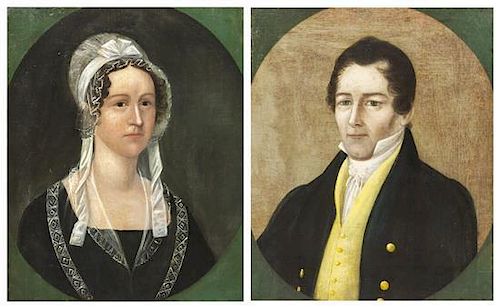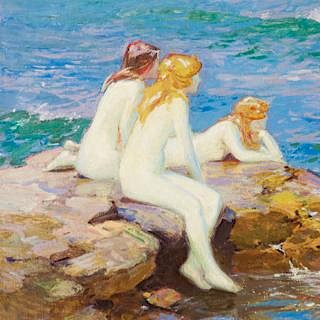* Joshua Johnson, (American, 1765-1830), Mr. and Mrs. Hilmer Schumacher (a pair of works), c. 1808-1810
Lot 148
About Seller
Hindman
1338 West Lake Street
Chicago, IL 60607
United States
Recognized as the Midwest's leading fine art auctioneers, Hindman Auctioneers has built a worldwide reputation based on a full service approach to the auction business tailored to meet the individual needs of our clients. Coming from a variety of educational backgrounds, specialists bring years of e...Read more
Categories
Estimate:
$25,000 - $35,000
Absentee vs Live bid
Two ways to bid:
- Leave a max absentee bid and the platform will bid on your behalf up to your maximum bid during the live auction.
- Bid live during the auction and your bids will be submitted real-time to the auctioneer.
Bid Increments
| Price | Bid Increment |
|---|---|
| $0 | $25 |
| $500 | $50 |
| $1,000 | $100 |
| $2,000 | $250 |
| $5,000 | $500 |
| $10,000 | $1,000 |
| $20,000 | $2,500 |
| $50,000 | $5,000 |
| $100,000 | $10,000 |
About Auction
By Hindman
Dec 10, 2014 - Dec 11, 2014
Set Reminder
2014-12-10 11:00:00
2014-12-11 11:00:00
America/New_York
Bidsquare
Bidsquare : American and European Art
https://www.bidsquare.com/auctions/hindman-auctions/american-and-european-art-338
Hindman Bidsquare@hindmanauctions.com
Hindman Bidsquare@hindmanauctions.com
- Lot Description
* Joshua Johnson
(American, 1765-1830)
Mr. and Mrs. Hilmer Schumacher (a pair of works), c. 1808-1810
oil on canvas
Each: 22 x 18 inches.
Estimate $ 25,000-35,000
Property from the Collection of Mr. and Mrs. Fred Seff, Chicago, Illinois
Provenance:
Mrs. Henry William Huntmuller
Thence by descent to Buckner Hollingsworth
Sold: Sotheby's Parke Bernet, New York, January 30, 1985
Michael Birdsall Art and Antiques, St. Paul, Minnesota
Acquired by the present owner from the above
Literature:
Carolyn J. Weekley, et al., Joshua Johnson: Freeman and Early American Portrait Painter, Maryland Historical Society, 1987, pp. 143-144, no. 52 & 53, illus.
Carolyn J. Weekley, "Joshua Johnson," The Magazine Antiques: Folk Art, September 1987, p. 526, pl. III, fig. 1, illus.
Exhibited:
Baltimore, Maryland, The Maryland Historical Society, Joshua Johnson: Freeman and Early American Portrait Painter, September 26, 1987 - January 3, 1988; Williamsburg, Virginia, The Abby Aldrich Rockefeller Folk Art Center, January 17 - May 15, 1988; New York, New York, The Whitney Museum of American Art, June 18 - August 25, 1988; Stamford, Connecticut, The Whitney Museum of American Art, September 9 - November 9, 1988
In the December 19, 1798 edition of the Baltimore Intelligencer, the artist Joshua Johnson described himself in an advertisement as a "self-taught genius," who could "execute all commands with an effect, and in a style, which must give satisfaction." Known as the earliest African-American painter active in the United States, Johnson was first listed as a portraitist in the Baltimore city directories in 1796. Long thought to be a slave belonging to the artist families Peale and Polk, he was in fact the son of a white man and a black slave, who was given his freedom in 1782, and whose independent career flourished until 1824.
The present pendant portraits were executed during Johnson's period of greatest activity, from 1803-1814, when he became more assured in his painterly skills. Both Mr. Hilmer (Helmer) Schumacher and his wife, Rachel, are painted in three-quarter view and with straightforward gazes, typical techniques of the artist's. Johnson also preferred background colors which complemented his sitters' costumes, as evidenced by the taupe background that sets off Mr. Schumacher's vibrant yellow waistcoat. Likewise, the intense green of the spandrels used in both portraits is seen elsewhere in the artist's work.
Hilmer Schumacher was living in Baltimore as early as 1810, when he married Rachel Cloberg. He was listed in the Baltimore city directories as a sugar refiner for a number of years, and the couple had one recorded son, Frederick, born circa 1812. The Schumacher's portraits were first documented in 1943 by the art historian and genealogist J. Hall Pleasants, when they were owned by a descendant of the sitters.
Please contact us for a complete condition report. - Shipping Info
-
For more information regarding shipping please visit Leslie Hindman Auctioneers' Shipping and Packing page.
-
- Buyer's Premium



 EUR
EUR CAD
CAD AUD
AUD GBP
GBP MXN
MXN HKD
HKD CNY
CNY MYR
MYR SEK
SEK SGD
SGD CHF
CHF THB
THB











